How should I take care of my cat or dog’s teeth?
Our pets need regular and consistent dental care to make sure their teeth stay healthy and functional for as long as possible, and to prevent dental plaque and tartar/ build up and dental and periodontal disease.
Dental plaque is a soft but sticky deposit of bacteria from saliva, food and fluid that coats the teeth and collects where the teeth and gums meet. These bacterial deposits can damage the tooth, lead to the formation of tartar, and cause periodontal disease.
Dental tartar (or calculus) forms when minerals from saliva are deposited into dental plaque, making it a hard layer that strongly bonds to the tooth enamel, making it difficult to remove except during professional cleaning.
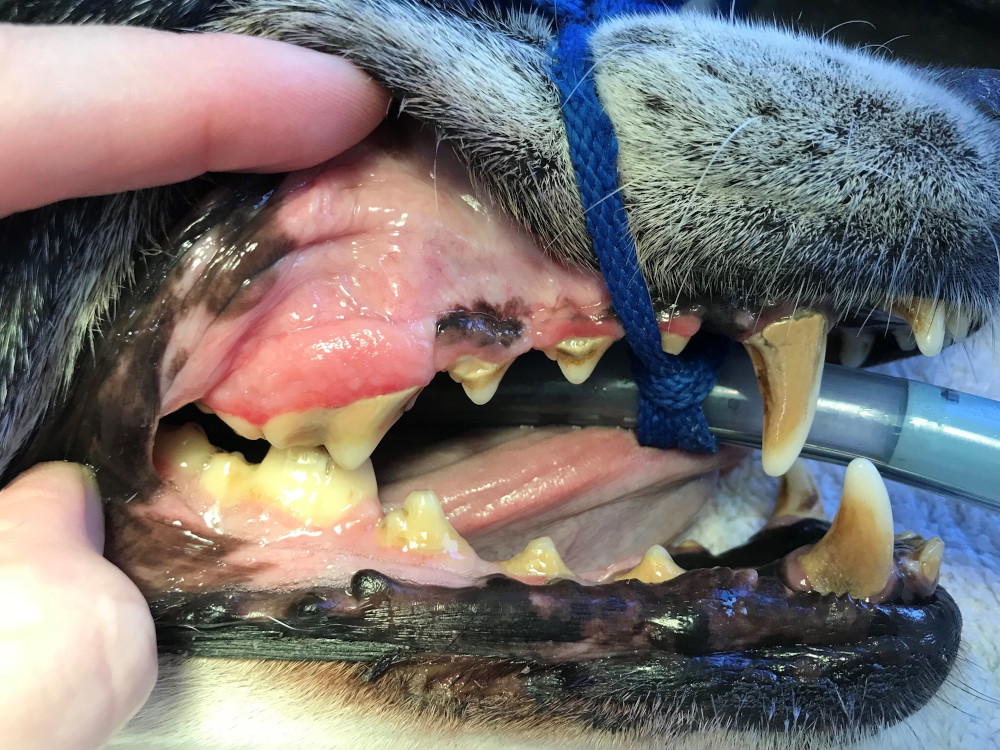
Photo provided by Dr Rebecca Nilsen
A dog’s teeth showing tartar build up before professional cleaning (image reproduced with permission).
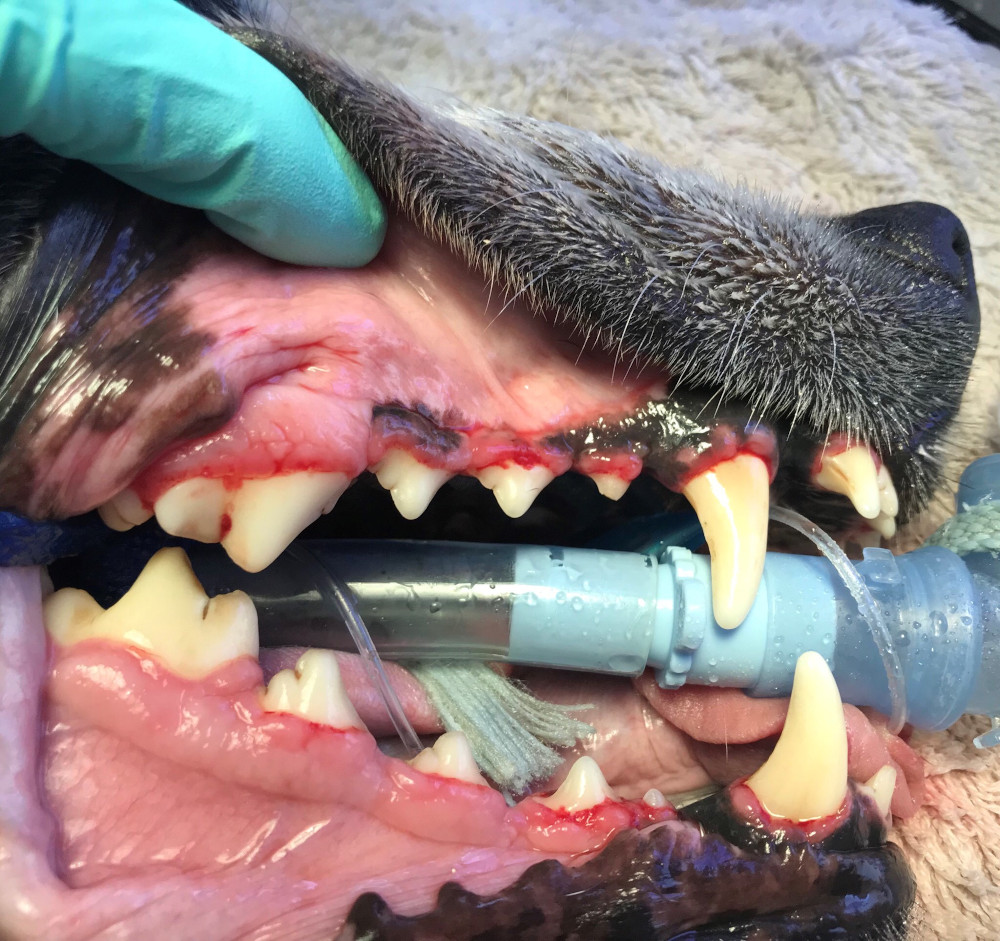
Photo provided by Dr Rebecca Nilsen
The same dog’s teeth after professional cleaning (image reproduced with permission).
Periodontal disease is a bacterial infection of the mouth and can be a very serious condition; it makes the gums inflamed and, eventually, destroys the bone surrounding and supporting the teeth. If left untreated, it can lead to tooth loss or the need for teeth to be removed. Periodontal disease is also associated with serious health problems such as infections in the kidneys, heart and liver. Thankfully it is easily preventable and also reversible if treated appropriately in its early stages.
It is important to take care of your pet’s teeth at home, they also need regular check-ups with a vet to really stay on top of their dental health.
Dental disease is the most common health condition affecting pets, with 70% of cats and 80% of dogs experiencing some level of dental disease by three years of age. Dental disease can cause significant pain to your pet and, as it advances, your pet could experience tooth and gum infection, inflammation, and bone and tooth loss, all of which can affect your pet’s general health too. So it is essential that good dental care for our pet is made a priority.
Home dental care for your pet
There are several things you can do at home to help ensure your pet’s teeth and gums are healthy.
The most effective way to promote good oral health in both cats and dogs is to brush their teeth daily – this may seem a little daunting but most animals will get used to their teeth being brushed. However, it is important that tooth brushing is introduced gradually and with the correct tools and technique. Generally, the younger your pet is when you start training them to have their teeth brushed, the easier it is. Seek advice from your vet as to when and how to start.
There are also special ‘dental’ diets for both cats and dogs, which can help to control plaque and tartar. You can speak to your vet about whether this is a good option for your pet.
Dental chews and toys are also available for both cats and dogs and can help to reduce the formation of plaque and tartar, although they will not prevent it. Your vet can give you advice on the most effective products.
Another alternative product that your vet may advise is a Chlorhexidine mouth wash or gel. These are used to help reduce the growth of bacteria in the mouth, which can contribute to dental disease.
Make sure your pet gets a vet check up every year
Your pet should have an annual visit to the vet to have a general health examination; a dental check-up is a very important part of this. At this visit, your vet will be able to assess your pet’s teeth and gum health, and provide advice on anything you need to manage at home. Your vet may recommend that your pet has a general anaesthesia to allow a full dental examination, cleaning of your pet’s teeth, dental x-rays if indicated, and the treatment of any specific problems (such as damaged teeth), if required.
All pet dentistry should be performed while your pet is fully anaesthetised
A full dental examination and cleaning of the teeth requires general anaesthesia. It is not possible to adequately examine all of the oral cavity and surfaces of the teeth, or perform dental x-rays to fully assess the condition of the teeth without general anaesthesia.
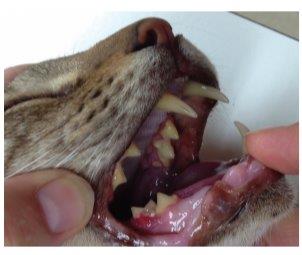
Photo provided by Dr Tara Cashman
Above: Tooth of a cat with gingivitis (shown by reddening of the gum, highlighted by the orange arrow), showing what looks like a relatively normal looking tooth (image reproduced with kind permission from Dr Tara Cashman, President of the Australian Veterinary Dental Society).
Below: The same tooth showing extensive destruction of both the tooth root and crown (the part above the gum line). This shows on the X-ray as grey fluffy looking areas (highlighted by the orange arrow and circle), compared this to the adjacent healthy tooth root and crown showing on the X-ray as a solid white tooth (highlighted by the green arrow and circle). This is a feline resorptive lesion and is a very painful condition. (Image reproduced with kind permission from Dr Tara Cashman, President of the Australian Veterinary Dental Society), demonstrating the importance of dental X-rays to uncover serious dental disease which could otherwise be missed.
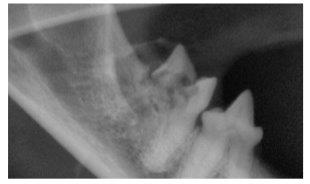
Photo provided by Dr Tara Cashman
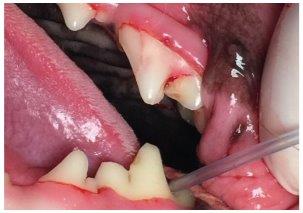
Photo provided by Dr Tara Cashman
Above: A dog’s tooth before probing (Image reproduced with kind permission from Dr Tara Cashman, President of the Australian Veterinary Dental Society).
Below: The same tooth as above after probing. There was minimal tartar present on the tooth before cleaning but there was this very painful fracture present – highlighted by the orange arrow and circle (Image reproduced with kind permission from Dr Tara Cashman, President of the Australian Veterinary Dental Society). This shows the importance of a full dental examination to discover serious dental disease which could otherwise be missed. It also demonstrates the importance of the patient being under anaesthesia so that they are unable to feel pain.
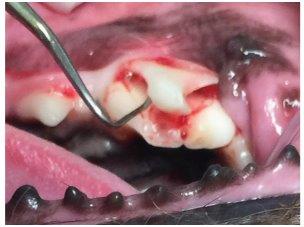
Photo provided by Dr Tara Cashman
Dentistry may also be painful. Probing under the gum line, scraping scale and tartar off teeth with an ultrasonic scaler, examining cavities, touching exposed tooth pulp and extracting teeth would cause pain and distress to your pet if they were not under anaesthetic.
Dentistry should only ever be performed under anaesthesia to prevent your pet from experiencing fear, stress and pain during the process.
Modern anaesthetic agents used by veterinarians are very safe; they are often the same anaesthetic agents used by human anaesthetists. Anaesthetised animals are closely monitored by veterinary staff and anaesthetic complications are rare. Even older pets and those with chronic diseases including heart or kidney problems, can undergo anaesthesia safely but may need some extra tests and precautions. Your vet can advise you on the best course of action.
With the right care and attention from you and your vet, you can keep your pet’s teeth and gums in great shape.
Was this article helpful?
This work is licensed under a Creative Commons Attribution-NonCommercial-NoDerivatives 4.0 International License.


